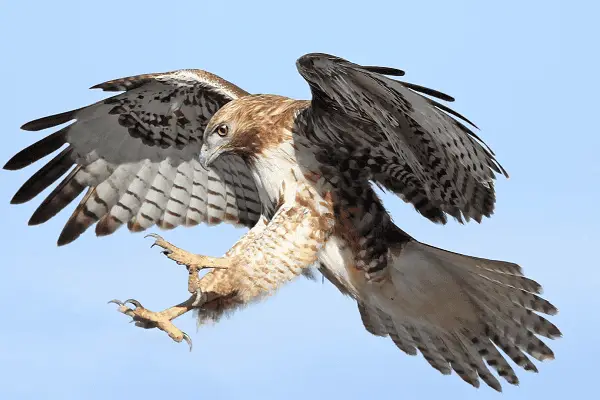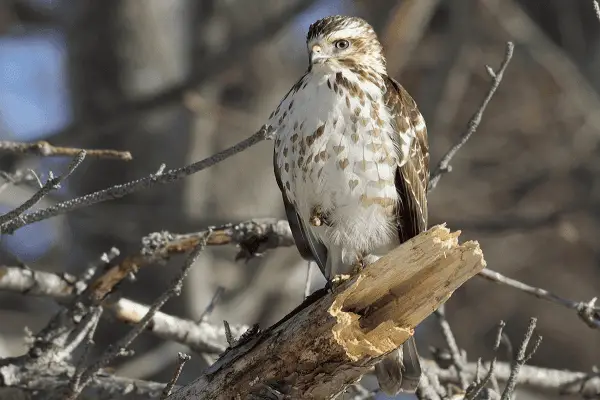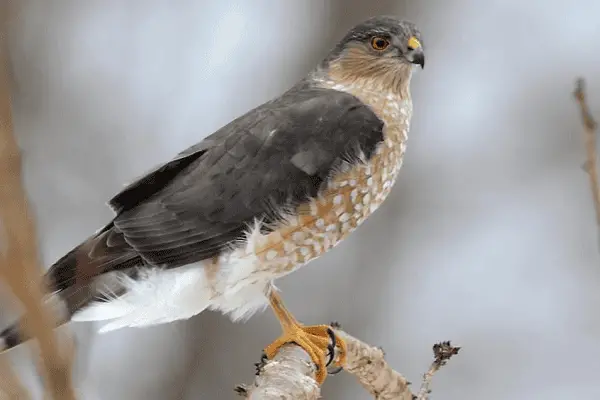Wisconsin is home to a diverse array of bird species, and hawks are no exception. These magnificent raptors can be found soaring through the skies and perching on treetops across the state. But did you know that Wisconsin is home to not just one or two, but 10 different species of hawks? From the iconic Red-tailed Hawk to the agile Cooper’s Hawk, each species has its own unique characteristics and habitats.
In this comprehensive ID guide, I will take you on a journey through the fascinating world of Wisconsin’s hawk species. Get ready to learn about their distinctive features, preferred habitats, and behaviors. With the help of pictures, you’ll have a handy reference to identify these impressive birds in the wild.
Here are the main points:
- Wisconsin is home to 10 different species of hawks.
- Each hawk species has its own unique characteristics and habitats.
- This ID guide will provide you with pictures for easy identification.
- Learn about the fascinating world of Wisconsin’s hawk species.
- Enhance your birdwatching experience by recognizing different hawk species.
1. Red-tailed Hawk
The Red-tailed Hawk is a magnificent and iconic species of hawk that can be found in Wisconsin. Known for its distinct red tail and broad wingspan, the Red-tailed Hawk is a sight to behold soaring through the skies.

Characteristic features of the Red-tailed Hawk include its large size, with adults typically measuring between 18-26 inches in length and having a wingspan of approximately 43-57 inches. These hawks have a wide range of color variations, with plumage that can be dark brown, light brown, or even reddish, depending on their age and region.
Found throughout North America, the Red-tailed Hawk is commonly seen in open areas such as farmlands, grasslands, and forests. They are adaptable birds and can be spotted perched on fenceposts, trees, or utility poles, patiently scanning the surroundings for prey.
The Red-tailed Hawk is a formidable hunter, feeding primarily on small mammals like mice, voles, rabbits, and squirrels. They also consume birds, reptiles, and even carrion when prey is scarce. With their keen eyesight and precise hunting skills, these hawks are true masters of the sky.
2. Cooper’s Hawk
Cooper’s Hawks are remarkable birds known for their exceptional flight skills and hunting abilities.I will explore the unique characteristics of Cooper’s Hawks, their preferred habitats, and provide pictures for easy identification.

Characteristics of Cooper’s Hawks
Cooper’s Hawks are medium-sized hawks with a length of 14-20 inches and a wingspan of 27-36 inches. They have a sharp, hooked beak that aids in capturing prey, as well as distinctive, rounded wings and a long tail for maneuvering through dense forest canopies.
One distinguishing feature of Cooper’s Hawks is their slate-gray and dark blue-gray plumage on their upperparts, which contrasts with their reddish or orangey-barred underparts. This coloration helps them blend seamlessly into their woodland habitat, making them excellent ambush hunters.
Their eyes are large and yellow, allowing for exceptional eyesight and accurate targeting while hunting. Additionally, their legs and feet are long and slender, perfect for agile movements and capturing prey.
Habitat of Cooper’s Hawks
Cooper’s Hawks can be found in a variety of habitats, including woodlands, forests, and suburban areas with mature trees. Though they are more commonly found in wooded environments, they have adapted well to urban landscapes and can often be spotted in parks and gardens.
These hawks prefer habitats with a mixture of open areas for hunting and dense vegetation for nesting and concealment. They are skilled at maneuvering through trees and shrubs, using their agility to surprise their prey.
3. Northern Harrier
The Northern Harrier, also known as the Marsh Hawk, is a unique hawk species found in Wisconsin. With its distinctive appearance and hunting behavior, the Northern Harrier stands out among the other hawk species in the region.

Characterized by their slim body, long wings, and owl-like facial disk, Northern Harriers are easily recognizable in flight. They have a wingspan of about 3-4 feet and a length of approximately 18-20 inches. The males have a grayish plumage with white undersides, while the females have brown feathers with streaks of white.
These hawks display a unique hunting technique known as “sky-dancing,” where they perform acrobatic aerial displays, hovering and gliding low over marshes and grasslands. Their preferred habitats include wetlands, marshes, and open grassy fields, where they search for small mammals, reptiles, and birds to feed on.
Observing Northern Harriers in their natural habitat can be a rewarding experience for bird enthusiasts and nature lovers. Their low-flying behavior and distinctive appearance make them a captivating sight.
4. Broad-winged Hawk
The Broad-winged Hawk is one of the migratory raptors that pass through Wisconsin during their annual journey. These stunning birds have unique characteristics that set them apart from other Wisconsin hawk species. Their banded tail and soaring behavior make them easily recognizable in the sky.

These hawks prefer wooded habitats, such as forests and woodlands, where they can dive through the trees and catch their prey. They are often found near water sources, like rivers and lakes, which provide ample hunting opportunities.
Here are some distinctive characteristics of the Broad-winged Hawk:
- Length: 13-17 inches
- Wingspan: 31-39 inches
- Coloration: Dark brown to black with a reddish-brown barred tail
- Behavior: Soaring in groups during migration, often forming “kettles” in the sky
5. Rough-legged Hawk
Rough-legged Hawks are a fascinating species of hawk that visit Wisconsin during the winter months. These majestic birds are known for their distinctive feathered legs, which set them apart from other hawk species. We will explore the characteristics, habitats, and behavior of Rough-legged Hawks, providing you with valuable insights and information.

Distinctive Features
The Rough-legged Hawk has several distinct features that make it easily identifiable. These include:
- Average size of around 19-24 inches in length, with a wingspan of 52-54 inches
- Feathered legs that extend down to their toes, providing insulation in cold weather
- Variation in plumage coloration, with light and dark morphs
- Dark patches on the leading edge of their wings
Habitat and Migration
Rough-legged Hawks prefer open habitats such as fields, prairies, and tundra. They are often found in northern regions, including Wisconsin, during the winter months, where they hunt small mammals such as voles and mice.
Identification and Pictures
Identifying a Rough-legged Hawk can be a rewarding experience, especially when you know what to look for. Here are some key characteristics to help you identify these stunning birds:
“The Rough-legged Hawk is a medium-sized hawk with a prominent white or light-colored underbelly and a dark-brown upper body. Its feathered legs are a unique feature that distinguishes it from other hawk species. When in flight, look for the dark patches on the leading edge of its wings, which are a reliable identification feature.”
By familiarizing yourself with the characteristics and appearance of Rough-legged Hawks, you’ll be able to easily spot these amazing birds during their winter visit to Wisconsin.
6. Sharp-shinned Hawk
Sharp-shinned Hawks are small but fierce predators that can frequently be spotted in the state of Wisconsin. These agile hunters have unique physical attributes that set them apart from other hawk species in the region. Let’s take a closer look at the characteristics, habitats, and behavior of the sharp-skinned hawk.

Characteristics
The Sharp-shinned Hawk is the smallest hawk species in Wisconsin, measuring around 10-14 inches in length. They have short, rounded wings and a long, narrow tail that helps them maneuver through dense vegetation. Their slate-blue back and wings, paired with a rufous-colored barred chest, make them easily identifiable.
One of the key features of the Sharp-shinned Hawk is its sharp, hooked beak, which allows it to tear its prey apart. These hawks also have long, powerful legs with sharp talons that enable them to capture and hold onto their prey securely.
Habitat
The Sharp-shinned Hawk is commonly found in a variety of wooded habitats, including dense forests, woodland edges, and suburban areas. They are highly adaptive and can be seen in both rural and urban environments. These hawks prefer habitats that provide cover and plenty of prey opportunities, such as small birds and mammals.
During their migration period, Sharp-shinned Hawks can be found in open areas, such as grasslands and prairies, where they can hunt and refuel before continuing their journey.
7. Red-shouldered Hawk and Other Hawk Species in Wisconsin
Now, let’s explore the remaining hawk species that can be found in Wisconsin. These include the Red-shouldered Hawk, Northern Goshawk, Swainson’s Hawk, and Ferruginous Hawk.

The Red-shouldered Hawk is known for its striking appearance. It has a reddish-brown shoulder patch and beautiful barred wings. These hawks can be found near water sources such as rivers and wetlands, where they hunt for snakes, frogs, and small mammals.
Next, we have the Northern Goshawk, a powerful and secretive hawk. These birds prefer mature forests as their habitat and are known for their agility and adept hunting skills. They prey on a variety of small to medium-sized animals, including rabbits, squirrels, and birds.
The Swainson’s Hawk is another hawk species that migrates through Wisconsin. These birds have a distinctive white throat patch and can often be found in grasslands and agricultural areas. Swainson’s Hawks primarily feed on small rodents and insects.
Last but not least, we have the Ferruginous Hawk, a regal and rare sight in Wisconsin. These hawks prefer open prairies and grasslands and are known for their rusty-red plumage. They primarily hunt for ground squirrels and other small mammals.
Each of these hawk species has unique characteristics, habitats, and behaviors, making them a thrilling sight for birdwatchers and nature enthusiasts. Scroll down to see pictures of these incredible Wisconsin hawk species for easy identification.
